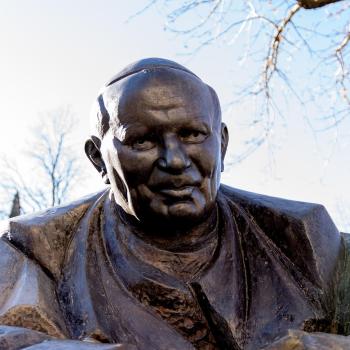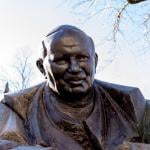LISA ASKS:
What exactly is the definition of “new age” thinking?
THE RELIGION GUY ANSWERS:
This loosely diffuse movement, largely located in America, is so indeterminate that it’s tempting to simply say “new age” covers any recently formed “spiritual” or “psychic” or “mindful” or “self-discovery” groups that don’t fit snugly into other religious categories. As part of this, new agers don’t fall within the formal organizational life of Buddhism or Hinduism but often appropriate various ideas and practices from Eastern religions, alongside other influences.
A good place to start is “Melton’s Encyclopedia of American Religions” (Gale), issued in eight updated editions, most recently in 2009. This standard reference work should be in any well-stocked library. Author J. Gordon Melton is a Baylor University professor whose decades of research make him the acknowledged expert on the taxonomy of U.S. faiths, especially thousands of young, small, marginal and obscure groups most people have never heard of. Note that the new age phenomenon extends well beyond formal organizations listed in such an encyclopedia to include free-floating ideas, fashions, books, gurus, and other influences.
Melton divides all U.S. religions into 24 categoties, one of which is the “Spiritualist, Psychic, and New Age Family,” which encompasses everything from the Swedenborgians to “drug-related” sects to flying saucer believers. His psychic or new age sub-category lists groups with such names as Inner Peace, Cosmic Wisdom, Mindstream, Psychiana, Natural Hygiene, Oneness United, and World Catalyst. Debatably, this is also where Melton places controversial faiths like L. Ron Hubbard’s Church of Scientology, Sun Myung Moon’s Unification Church, and Jim Jones’s homicidal People’s Temple (though it was affiliated with the respectable Christian Church — Disciples of Christ).
Melton distinguishes “new” age from “ancient wisdom” creeds like Rosicrucianism and Theosophy. He also sees links with venerable “occult” (that is, hidden wisdom) practices such as astrology, numerology, tarot cards, palm reading, and divination. New age literature and coursework may refer to the Bible, but mostly in terms of alleged esoteric truths a la ancient Gnosticism, as opposed to mainstream Judaism and Christianity (though there’s overlap on the margins). Melton says the movement centers on consciousness rather than doctrines, and that while typical groups are “very loosely organized,” some are “highly structured and even authoritarian.”
Where did the movement come from? Melton says America in the early 1970s saw the emergence of an identifiable “new generation of psychic / occult / spiritual seekers” after years of work by visiting Eastern gurus. Idealists focused on mental and spiritual self-transformation to ennoble the individual soul amid “hope for a coming age of love and peace.” The young movement produced a best seller, “Be Here Now” by Baba Ram Dass (formerly Harvard psychologist Richard Alpert); a magazine, the “East-West Journal”; and group directories, the “Year One Catalog” and the “Spiritual Community Guide.”
Another source is “Understanding the New Age” by The Guy’s colleague Russell Chandler (out of print but available on amazon.com). Chandler was an award-winning religion writer for the “Los Angeles Times” right at the epicenter of new age turf. He took an eight-month leave from the newspaper to research this objective overview. As a 1988 book, the many particulars on groups and gurus are dated but useful for historical purposes, and there’s good material on movement beliefs.
With such a variegated phenomenon, Chandler advises, we should speak of “new age movements” in the plural. Yet these groups do share a broadly agreed vision of spiritual reawakening that rejects the “establishment” and the one personal God worshipped in Judaism, Christianity, or Islam. Chandler summarizes new age teaching in three words, “all is one,” or this extended version: “All is One. We are All One. All is God. And we are God.” In technical language this is “monism” plus “pantheism.” Chandler says “humans, like everything else, are an extension of the Oneness, which is all the divinity there is.” Thus “the only ‘miracles’ are natural ‘processes’ of impersonal energy.” Likewise, all world religions are seen as essentially one and lead us toward the cosmic unity. However, one old-age dogma is widespread, reincarnation and the law of karma, in which the universe dispenses rewards and punishments in the next life for deeds performed in this life.
A current scholar, Benjamin Zeller of Lake Forest College, says part of the original appeal was countercultural rejection of middle-class tradition (including church and synagogue). He says “few Americans remained longer than a few years in the new religions.” Likewise, Melton says the movement peaked in the 1980s and has gradually declined. Zeller notes the popularity of dietary preachments, especially vegetarianism, and of alternative medicine, for instance crystals, herbalism, acupuncture, and Japan’s Reiki, along with other Asian concepts such as China’s power placement of objects (feng shui) and I Ching oracles. He says another recent trend is a breakaway resulting from stronger self-identity among “pagans” who pursue “a re-imagined European past and the gods of antiquity.”
Further new age information is available at www.patheos.com/Library/New-Age.html.












